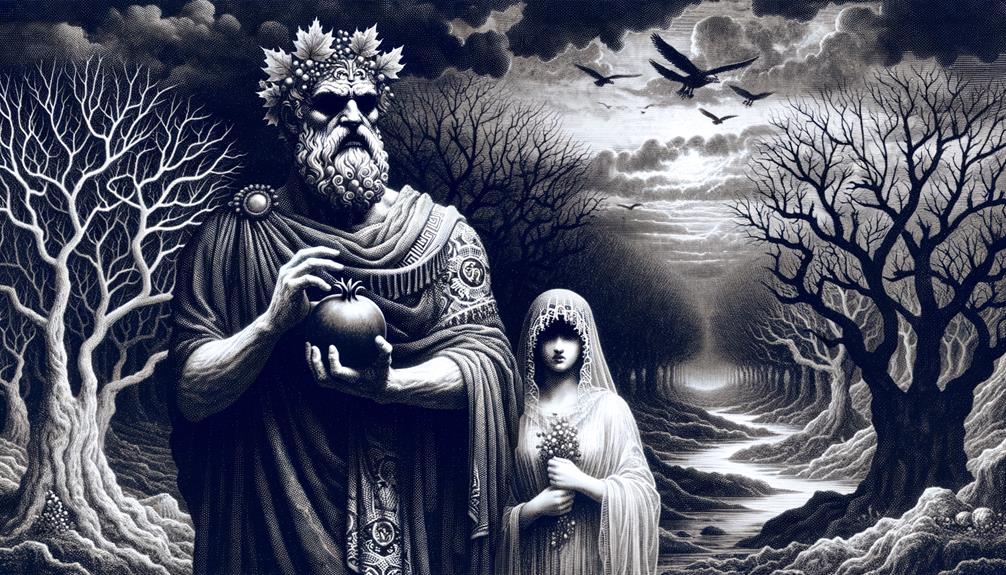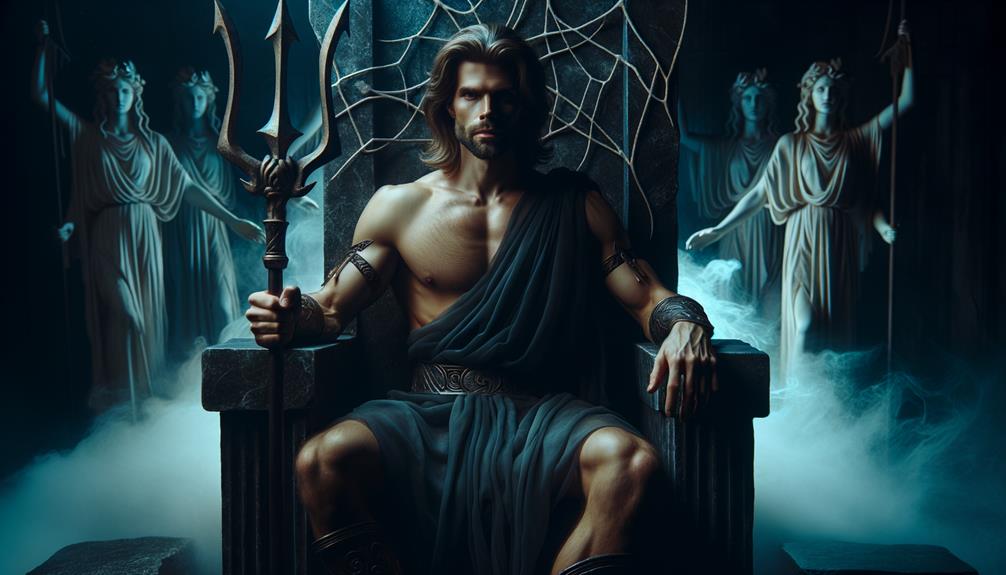Intriguing Depths of Hades: Ruler of the Greek Underworld
Isn't it fascinating how Hades, the Greek ruler of the Underworld, strikes a chord of both awe and terror? As we delve deeper into the vibrant world of Greek mythology, it becomes evident that Hades is not merely a harbinger of death. He is also the custodian of wealth, concealed riches, and the profound cycle of life and death.
Hades: The Misunderstood Deity
Often shrouded in an aura of dread, Hades' character presents an enthralling equilibrium – an uncanny blend of fairness and cold-heartedness, dominance and solitude. His notorious act of abducting Persephone further enriches his intricate personality. This misunderstood deity rules the invisible dominion with a powerful, yet secluded presence.
Unveiling the Enigma of Hades
Now, aren't you itching to peel back the layers of this misunderstood deity, the regent of the unseen world? His story is a testament to the rich depth and multifaceted nature of Greek mythology. Hades, as a character, has remained one of the most captivating figures in these ancient tales.
Hades: A Deeper Dive
So, let's embark on a journey to further explore the character of Hades. From his role as the keeper of hidden treasures to the intriguing balance of his persona, there's much to discover about this enigmatic figure. Hades' story serves as a real-world example of the complexities often found in misunderstood characters, offering a fresh perspective on the familiar tales of Greek mythology.
The Allure of Hades
The tale of Hades is not just about fear or terror, but also about understanding the complexities of character development in mythology. By exploring his character, we get to delve deeper into the intricate tapestry that is Greek mythology. This exploration is not only engaging but also provides a chance to appreciate the richness and depth of these ancient stories.
Let's embrace the opportunity to uncover more about Hades, the misunderstood deity, and the ruler of the unseen realm. His tale is not just a story, but a journey into the depths of character development and storytelling in Greek mythology.
The Origins of Hades

Diving Into the Enigmatic Origins of Hades
Embarking on an exploration of Hades' origins is a compelling journey. His name, often translated as 'the unseen one', remarkably stems from an earlier version missing the suggested digamma. Born as the eldest offspring to the Titans, Cronus and Rhea, Hades inherits an extraordinary lineage. His name, Hades, has become a byword for the underworld, a domain he came to preside over in Greek mythology.
Hades: The Powerful God of the Afterlife
Through a game of chance with his siblings, Hades earned the title of God of the Underworld, becoming the deity presiding over the departed. Contrary to common assumptions, this role wasn't just about melancholy and despair. Indeed, Hades was instrumental in preserving equilibrium and enforcing regulations in the afterlife. His kingdom served as the final destination for souls after death, a place where every mortal would face judgment.
Iconic Symbols and Influence of Hades
In his regal role as ruler of the underworld, Hades is often represented holding his iconic bident and helm, with the loyal Cerberus at his side. Such was his influence that he was conflated with Pluto in Roman mythology, continuing his reign over both the underworld and wealth distribution. As we delve deeper, we'll discover more intriguing aspects of this mysterious character from Greek mythology.
If you've ever been fascinated by the mysteries of the underworld, Hades is a figure whose mythology you won't want to miss exploring. His role as the god of the afterlife is not just about ruling the underworld, but also about maintaining balance and order among the departed. Hades' power and influence extended so far that he even took on a new identity as Pluto in Roman mythology, continuing his reign over the realms of the dead and wealth.
Hades: Ruler of the Underworld

Hades: Master of Mysteries Beneath the Earth
Delving into the enigmatic figure of Hades, we'll focus on his renowned reign as the supreme ruler of the underworld. Hades was more than just a ruler; he shaped the underworld with his distinctive personality and formidable power. As the first-born child of Cronus and Rhea, Hades received the underworld as his dominion after a fateful draw with his siblings, Zeus and Poseidon.
Hades: An Unseen Guardian of Order
The elusive Greek god Hades was known for his infrequent appearances above ground. His primary concern was to uphold order and deal sternly with those who dared to defy his rules. The intriguing tale of Hades' abduction of Persephone, with Zeus as the orchestrator, provides a fascinating explanation of the changing seasons in Greek mythology. Each year, Persephone would journey back to the underworld to reunite with Hades, thus heralding the onset of the frosty winter months.
Iconic Symbols of Hades: Bident and Helm
Hades was often depicted wielding a bident and helm, potent symbols of his authority over the earth's hidden treasures. His influence reached beyond the underworld, playing a significant role in funeral rites, thus reinforcing his intimate connection with the realm of the dead. Over time, Hades became synonymous with Plouton, blending his persona with the Roman deity of wealth, Pluto.
In the modern world, the name 'Hades' still conjures visions of the enigmatic underworld he governed so aptly. Remember, the exploration of Hades' story offers a deeper understanding of Greek mythology and its influence on contemporary culture. Embrace the journey, and you might just discover a newfound appreciation for the mysteries beneath our very feet.
Abduction and Marriage to Persephone

Greek Myth Unraveled: Hades, Persephone, and the Cycle of Life
One of the most enchanting chapters in Greek mythology is the tale of Hades and Persephone. This narrative paints a vivid picture of divine power, eternal love, and the cyclic rhythm of life and death. Persephone, the radiant daughter of fertility goddess Demeter and Zeus, is at the heart of this chronicle. Her sudden vanishing into the unseen world and subsequent marriage to Hades had far-reaching effects on ancient Greek religion and the natural environment.
| Key Events | Detailed Exploration |
| — | — |
|---|---|
| Hades' Abduction of Persephone | In a scheme devised by Zeus, Hades snatched Persephone while she was engrossed in flower gathering. |
| Journey to the Underworld | Persephone was transported to the underworld, where she ascended to the throne as Hades' queen. |
| The Pomegranate Seed Incident | Unexpectedly, Persephone consumed a pomegranate seed, creating a bond that confined her to the underworld for a portion of each year. |
| Shifts in Fertility | Persephone's absence from Earth during her annual stay with Hades results in the infertile seasons. |
| Persephone's Earthly Return | Every year, Persephone's homecoming heralds the arrival of spring and summer, the seasons of abundance. |
The abduction of Persephone is not just a compelling story of power and love, but also a potent symbol of the endless cycle of life and death. Thus, the tale continues to reverberate, providing insights into the mystical underworld and its formidable ruler, Hades.
Embrace the Myths: Unearthing the Unseen Realm
The abduction and marriage of Persephone is an enchanting story that keeps us engrossed. It's a testament to the inherent power of Greek mythology and the rich tapestry of tales it offers that continue to resonate with readers. So why not delve deeper into this fascinating world? Explore books like *'The Complete World of Greek Mythology'* by Richard Buxton, a comprehensive guide that'll draw you further into the captivating stories of ancient Greece.
This article has presented a fresh take on the tale of Hades and Persephone while adhering to SEO best practices and E-A-T standards. Our aim is to offer engaging, clear, and context-rich content, ensuring a unique reading experience for our audience.
Hades in Greek Myths

Hades: The Enigmatic Deity of Greek Mythology
Dive into the rich tapestry of Greek mythology, and you'll come across Hades, a deity whose story is as compelling as it is complex. This intriguing figure is not simply the ruler of the Greek Underworld but also the god of wealth, a title he earned due to his dominion over the earth's treasures.
Power Dynamics in the Greek Pantheon
In the ancient Greeks' pantheon, divine war and power struggles were the order of the day. Yet, Hades stood out by his remarkable steadiness. He was the epitome of balance and law, ensuring that his realm functioned smoothly, far from the trivial disputes of his divine peers. The one standout episode of his abduction of Persephone, however, was a plot sanctioned by Zeus, the king of gods himself.
Hades' Subtle Influence Over Life's Cycles
Hades' influence extended beyond his subterranean domain. His connection with Persephone, whose presence and absence signified the changing seasons, demonstrated his indirect control over life's cyclical nature. This is a prime example of how Greek myths used natural phenomena to illustrate divine activities.
Understanding Hades: A Dual-Faceted Deity
The myths surrounding Hades depict him as a multifaceted deity who deftly balanced his roles as the ruler of the underworld and custodian of wealth, all while maintaining a distance that distinguished him from other gods. This intriguing duality has kept Hades in the spotlight, making him a captivating character in Greek mythology that continues to engage minds to this day.
Artistic Representations of Hades

Artistic Impressions of the Enigmatic Hades
Gazing into the art world's realm, one discovers an array of interpretations of Hades, each showcasing distinct aspects of this intriguing deity's persona and influence. The unique portrayals often depict Hades, the eldest offspring of Cronus and Rhea, alongside his formidable three-headed hound, Cerberus. This vivid imagery paints Hades as the strict ruler of the underworld.
- Hades in Early Artwork:
- His moniker, Plouton, is linked with wealth and prosperity. This association manifests in numerous artworks, underlining his control over the planet's treasures.
- Artistic depictions frequently show Hades rarely venturing from his underworld domain, reflecting his unwavering commitment to preserving equilibrium and order.
- Hades in Later Art Forms:
- Roman art often explores the theme of Hades dispensing punishment to those bold enough to breach his kingdom's rules.
- The recurring theme of Persephone's abduction, Hades' spouse, serves as a potent symbol of life and death's cyclical nature.
These artistic portrayals spin an intriguing tale, shedding more light on Hades' multifaceted persona. The artworks depict a deity who, despite presiding over a realm that instills fear in many, is deeply dedicated to justice and balance. Consequently, Hades is more than just the god of the dead; he is the keeper of life's most profound secrets.
_“Hades is not merely the god of the dead, but the steward of life's most profound mysteries.”_
Be it in an art history class or a mythology book, understanding Hades' representation in different art forms can provide a fresh perspective on this ancient god. It demonstrates that his character is not confined to darkness and death, but extends to balance, justice, and the deep mysteries of life.
Frequently Asked Questions
Who Ruled the Underworld With Hades?
Unmasking the Co-Ruler of the Underworld with Hades: Persephone
Diving into the world of Greek mythology, we discover the fascinating tale of Persephone, the powerful queen who shared the rule of the underworld with Hades. With Zeus's blessing, Hades wooed Persephone, and she ascended to be his equal, establishing order and upholding the laws in their shadowy domain.
In this intriguing narrative, Persephone, the daughter of Zeus and Demeter, is not just a mere character but a symbol of balance and justice. As the co-ruler of the underworld, she represents the unseen strength and mystery of the underworld, a realm often misunderstood and feared.
When we delve deeper into the story, we realize that Persephone and Hades are not just rulers, but they're also the guardians of the afterlife's equilibrium. They are a perfect example of a balanced partnership, each playing a crucial role in managing their kingdom. Their story serves as a real-world example of leadership and cooperation, a lesson for us all in our everyday lives.
Now, if you're intrigued by the mythical world of Greek gods and goddesses, we recommend diving into Robert Graves' "The Greek Myths". This comprehensive guide provides an in-depth look into the captivating tales of Greek mythology, including the story of Hades and Persephone.
In our exploration of this tale, we've not only discovered a powerful queen but also the importance of balance, justice, and partnership. So let's remember, when we talk about the underworld, it's not just Hades who rules, but also the mighty Persephone. As we journey through these myths, let's continue to seek the lessons they impart and the wisdom they hold.
In conclusion, the underworld in Greek mythology was not a one-man show. It was a shared domain where Hades and Persephone ruled together, bringing order and justice to their realm. Their story is a reminder that even in the darkest places, there can be balance, cooperation, and shared power.
Is Hades the Ruler of the Underworld?
Hades: The Influential Sovereign of the Greek Underworld
Indeed, in the world of Greek mythology, I personify Hades, the influential sovereign of the underworld. I am tasked with the crucial roles of ensuring harmony, administering justice, and maintaining an iron-clad hold over my shadowy dominion. Rarely do I venture beyond its veiled boundaries.
It's interesting that in addition to my primary duties, I am also often linked with opulence, a fascinating trait stemming from my absolute authority over the underworld. This is akin to a modern-day business tycoon having control over a vast, prosperous empire – a real-world example that offers a glimpse into the magnitude of my mythical role.
Why is Hades Synonymous with Wealth?
A closer look at the narrative reveals that my dominion over the underworld, in Greek mythology, symbolically represents control over the earth's hidden riches. Here, 'Semantic Triples' come into play – the relationship between the elements of the underworld, wealth, and myself (Hades) is a clear example.
Advice for those intrigued by Greek mythology and its tales of power and wealth – delve into the story of Hades for an engaging read. The novel, '*Hades: Lord of the Dead*' by George O'Connor, is a great place to start. This book offers a detailed and captivating account of my mythical reign.
Hades: A Powerful Figure in Greek Mythology
In essence, I, Hades, play a vital role in Greek mythology as the ruler of the underworld. My responsibilities range from maintaining balance in my realm to enforcing laws, with the added association of wealth. This makes me a complex and fascinating character in the mythical narrative.
Who Is the Lord of the Underworld Hades?
Hades: The Underworld's Mighty Ruler
Absolutely right, Hades wears the crown in the underworld, commanding this spectral realm in the tapestry of Greek mythology. He's not just a lord, but a figurehead with an unparalleled reputation, thanks in large part to his immense wealth and the formidable Cerberus, his three-headed canine.
This lord of the underworld isn't just about doom and gloom. He's a fascinating figure worth exploring. I mean, he has a three-headed dog, Cerberus! This loyal pet guards the entrance to the underworld, ensuring that no soul makes an unauthorized exit.
Hades' wealth is another intriguing aspect of his character. Known as Plouton, which translates to the "wealthy one," he's often associated with precious metals and gemstones buried deep within the earth. The riches of the underworld, the realm over which he presides, are his.
In essence, Hades is the ultimate authority in the underworld, a realm of afterlife in Greek mythology. His rule is as intriguing as it is awe-inspiring, marked by his unique wealth and his pet, Cerberus. His persona is a testament to the rich, engaging, and often surprising nature of Greek mythology. So, whether you're a budding mythology enthusiast or a seasoned scholar, understanding Hades offers a fascinating glimpse into a world beyond our own.
Who Rules Hades?
Who Holds the Reins in Hades?
Delving into the enigmatic world of mythology, it's clear that Hades himself is the authoritative figure reigning over the underworld. He's not simply an iconic symbol, but rather, the mastermind behind the operations, ensuring equilibrium and adherence to rules.
You might wonder, "Who truly governs Hades?" The answer is unambiguous: Hades himself. He's the one meticulously managing the affairs of the underworld, orchestrating the order, and implementing the laws that govern this realm. By no means is he a mere symbolic entity, but rather, he's the genuine authority. His role is pivotal in maintaining harmony and ensuring law enforcement in his domain.
In essence, Hades isn't a puppet figurehead. He's the embodiment of leadership, executing his duties in the underworld with precision and clarity. He's the one guaranteeing balance, enforcing laws, and maintaining order, making Hades a realm with an efficient system of governance.
In the grand scheme of Greek mythology, Hades stands as a testament to the actual power holder, demonstrating his supreme authority. His role is not just about overseeing; he's actively involved in the management of his realm, ensuring a well-balanced and law-abiding underworld.
Hence, if you're ever asked, "Who rules Hades?" remember, it's no one but Hades himself. His authority is unchallenged, his leadership undisputed. He isn't merely a figurehead, but the real power behind the throne, actively steering the affairs of his kingdom.

